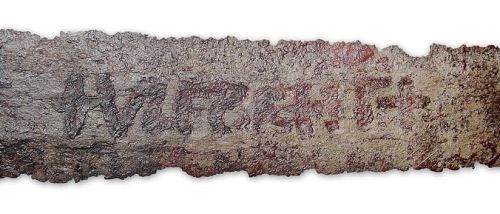Find the source of the legendary Viking sword
Ulfberht in the Middle Ages in Europe was a sword brand like Gucci in the fashion industry now, even more so. The quality of these swords is raised to the level of . legend.
Origin of the legendary sword of the Viking
Only a few dozen such swords were crafted from metal with sophistication and sharpness that even modern scientists were amazed. They were found throughout Europe with some broken pieces of swords. These swords are named Ulfberht and two crosses.
A new study has helped us get closer to the origin of the sword and smithy they were born. Initially, scientists hypothesized that swords originated from the Middle East or Asia, which at the time had forged technology ahead of Europe, but new research shows that swords may have origin in Central Europe.

The Viking Ulfberht's legendary sword.(Photo: Martin Kraft / Wiki Commons.)
At the time of Ulfberht swords (around 800-1000), swords with similar material and quality made from Damascus steel were also being produced in the Middle East. Both Damascus steel and Ulfbehrt forged steel have a very high carbon content.
Carbon content determines the material of a sword. During sword forging, controlling this is extremely important. If not controlled, the sword will become too soft or too brittle. Controlled, carbon will make the sword much stronger.
The Ulfberht sword has three times the carbon content of the same sword, making it much stronger, but also more flexible and lighter. The Ulfberht sword also has almost no rust.
Before Ulfberht was found, scientists thought that humans only reached such metal levels during the industrial revolution. Iron ore must be heated to 3,000 degrees Fahrenheit (1,648 degrees Celsius) to reach the same level as the Ulfberht sword, forged before the 800-year era.
With great effort and accuracy, modern blacksmith Richard Furrer of Wisconsin, forged a sword with Ulfberht's quality with medieval methods and techniques . He said it was the best thing he ever did.

The Taunus mountain range in Germany, which is believed to have the material that makes up the legendary Ulfberht sword.(Photo: Chris Kuem / Wiki Commons.)
With swords made of Damascus steel in the Middle East, they were born much longer, around 300 BC, but the technique was lost in the region in the middle of the 18th century.
Many technologies equivalent to modern metallurgical technology have been implemented to produce the Damascus swords , such as adding chemicals to the sword forging process to create chemical reactions at the molecular level. , according to archaeologist K. Kris Hirst.
Hirst led a study led by Peter Paufler of the University of Dresden, Germany, published in the 2006 Nature journal. Paufler and his team conducted experiments with chemicals available in the Middle East region at the moment. Great and create the necessary response.
" Metal developed a 'carbon nanotube' (CNTs) differential structure, covering the surface of the sword with a hard, nearly carbon-like diamond, making the sword extremely sharp and unstoppable", Hirst explain.
The ingredients that were added during the forging of Damascus swords were yellow bean bark, earrings, vanadium, chromium, manganese, cobalt, nickel and some other rare chemicals.'Perhaps since the middle of the 18th century, chemicals for sword training were harder to find, depleted or deformed, causing techniques to practice swordplay ', Hirst explained.
But the Ulfberht sword has nothing to do with the Damascus sword, according to a new study. Robert Lehmann, a chemist at the Institute of Inorganic Chemistry at the University of Hannover, Germany, wrote in Deutsche Sued magazine in October that materials made for Ulfberht 'certainly do not come from the East' .
He has studied Ulfberht swords since 2012 after they were excavated from an archaeological site near the Weser River that flows through the Lower Saxony region in northwestern Germany. The blade has a very high manganese content, which makes Lehmann believe it does not originate from the East.
The sword's barrier is made of high arsenic steel, showing that the sword is of European origin. The part of the apple that grips the sword is coated with lead-tin alloy.
Lehmann studied maps of the distribution of lead isotopes in Germany and determined the part of the sword-making apple made from a lead found in the Taunus region, north of Frankfurt, Germany.
This shows that Ulfberht is actually a sword of entirely European origin.
- What priceless sword warrior does the Viking warrior possess?
- Treasures Viking 1,200 years old revealed under the neck
- The sword earns thousands of years of Viking forms
- Detect fragments of 100 ancient swords
- The 1,000 year Viking wooden sword is still intact, not decaying: Made from expensive wood like gold!
- 10 legendary swords in world history
- Three legendary swords 'both strange and familiar' in Japanese history
- The mystery of the legendary stone sword of San Galgano
- There used to be a legendary Viking civilization
- Discover interesting facts about Vikings
- The sword remained intact after 1,200 years in the Norwegian mountains
- An 8-year-old girl found a 1,500-year-old sword
 'Fine laughs' - Scary and painful torture in ancient times
'Fine laughs' - Scary and painful torture in ancient times The sequence of numbers 142857 of the Egyptian pyramids is known as the strangest number in the world - Why?
The sequence of numbers 142857 of the Egyptian pyramids is known as the strangest number in the world - Why? History of the iron
History of the iron What is alum?
What is alum?